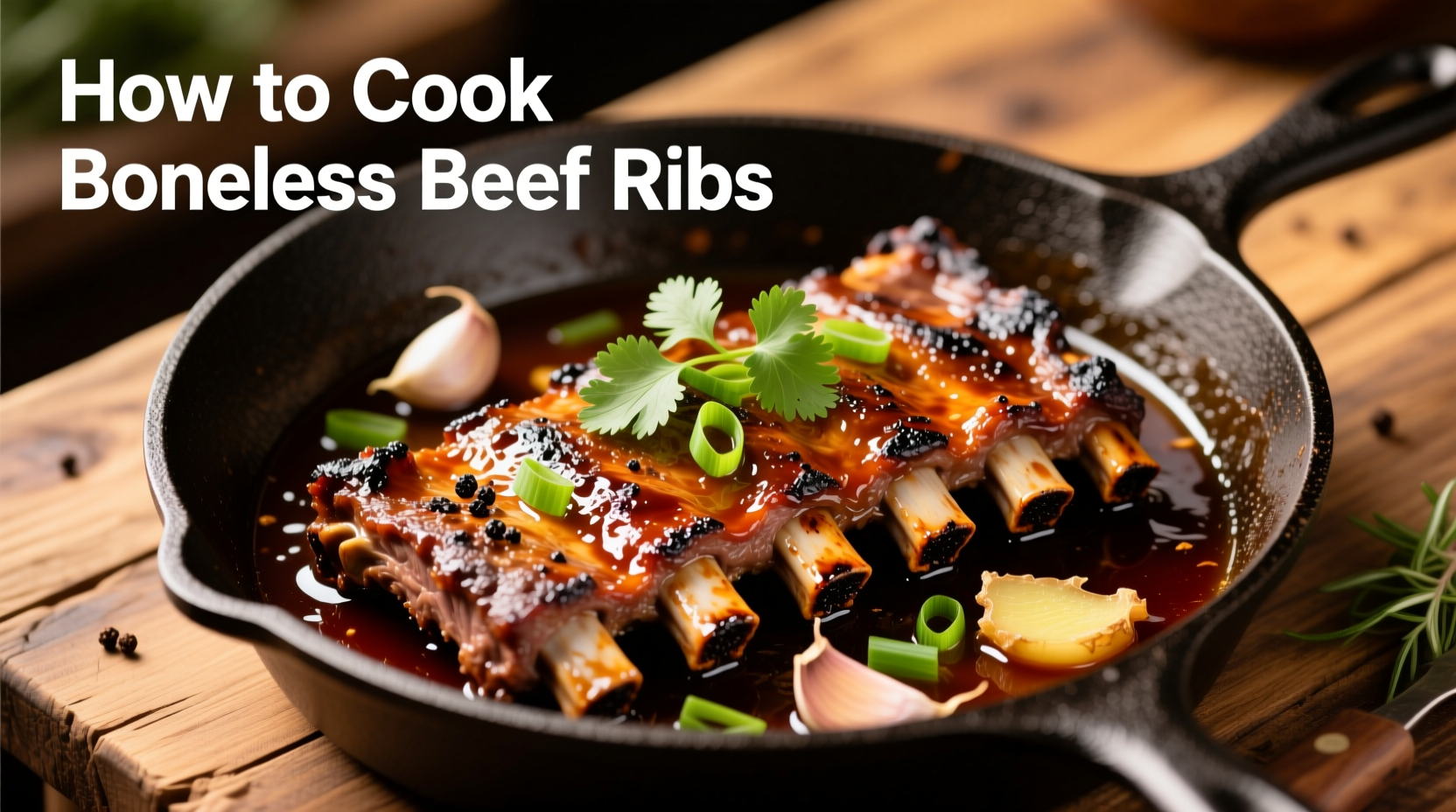What Exactly Are Boneless Beef Ribs?
Despite the confusing name, boneless beef ribs aren't actually ribs at all. Butchers typically cut them from the chuck or plate section, specifically the rib meat that runs between traditional rib bones. These cuts contain the same marbling and connective tissue as traditional ribs, making them ideal for slow cooking methods that transform tough collagen into succulent gelatin.

Why Your Previous Attempts Might Have Failed
Most home cooks make these critical mistakes with boneless beef ribs:
- Cooking at too high a temperature (above 325°F)
- Not allowing sufficient time for collagen breakdown
- Skipping the crucial resting period before slicing
- Using lean cuts marketed as "boneless ribs" that lack proper marbling
| Cooking Method | Temperature | Time Required | Best For |
|---|---|---|---|
| Oven Roasting | 275°F | 3-4 hours | Consistent results, hands-off cooking |
| Smoker | 225-250°F | 4-5 hours | Authentic smoke flavor development |
| Slow Cooker | Low setting | 8-10 hours | Maximum tenderness, minimal monitoring |
Step-by-Step Cooking Guide
1. Selecting Quality Meat
Look for well-marbled cuts with visible fat streaks throughout. The USDA recommends choosing beef with at least moderate marbling for optimal results with slow-cooked preparations (USDA Food Safety and Inspection Service). Avoid pre-trimmed "lean" versions marketed as boneless ribs, as they lack the necessary fat for proper tenderization.
2. Proper Preparation
Remove only excess surface fat, preserving the marbling within the meat. Pat completely dry with paper towels - this critical step ensures proper bark formation during cooking. For best results, apply your seasoning rub 12-24 hours before cooking to allow flavors to penetrate deeply.
3. The Perfect Seasoning Blend
Professional chefs recommend this balanced dry rub ratio for 2 pounds of boneless beef ribs:
- 3 tablespoons coarse kosher salt
- 2 tablespoons black pepper (freshly cracked)
- 1 tablespoon smoked paprika
- 1 tablespoon garlic powder
- 1 teaspoon cayenne pepper (optional for heat)
- 1 teaspoon mustard powder
Apply rub evenly on all sides, pressing gently to adhere. Let rest at room temperature for 45 minutes before cooking.
4. Cooking Methods Compared
Oven Method (Most Consistent Results)
- Preheat oven to 275°F
- Place ribs on wire rack over baking sheet
- Cook for 3 hours, then check internal temperature
- Continue cooking until reaches 195-205°F (typically 1-2 more hours)
- Wrap in butcher paper or aluminum foil during final hour for enhanced tenderness
Grill/Smoker Method (Best Flavor)
- Maintain steady 225-250°F temperature
- Use indirect heat with wood chunks (hickory or oak recommended)
- Smoke for first 2 hours, then wrap in foil with 1/4 cup beef broth
- Continue cooking until internal temperature reaches 195-205°F
Slow Cooker Method (Easiest Approach)
- Place seasoned ribs in slow cooker
- Add 1/2 cup beef broth or stock
- Cook on low for 8-10 hours
- Transfer to baking sheet and broil for 5 minutes to develop crust
Troubleshooting Common Problems
Dry or Tough Results
This indicates insufficient cooking time or temperature too high. The collagen in boneless beef ribs requires sustained heat between 195-205°F to fully break down. Never pull ribs before reaching this temperature range, regardless of appearance. If already cooked, slice thinly against the grain and serve with additional sauce or broth.
Excessive Shrinkage
Boneless beef ribs naturally shrink 30-40% during cooking due to fat rendering. To minimize shrinkage:
- Start with well-marbled cuts
- Cook at proper low temperatures (under 300°F)
- Wrap during final cooking phase to retain moisture
Professional Serving Techniques
Let cooked ribs rest for 20-30 minutes before slicing - this allows juices to redistribute. Slice against the grain at 1/4-inch thickness for optimal tenderness. Serve with these complementary sides:
- Creamy mashed potatoes (absorbs rich juices)
- Charred asparagus (cuts through richness)
- Apple cider vinegar slaw (provides acidity balance)
Storage and Reheating Guide
Store leftovers in airtight container with cooking juices for up to 4 days. For best reheating results:
- Oven method: Wrap in foil with broth, heat at 250°F until internal temperature reaches 140°F
- Slow cooker method: Low setting with 1/4 cup liquid until heated through
- Never microwave, as it creates uneven heating and tough texture











 浙公网安备
33010002000092号
浙公网安备
33010002000092号 浙B2-20120091-4
浙B2-20120091-4